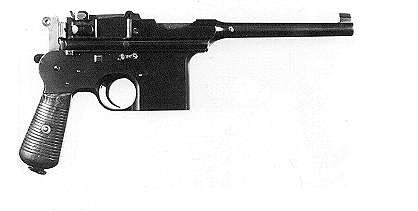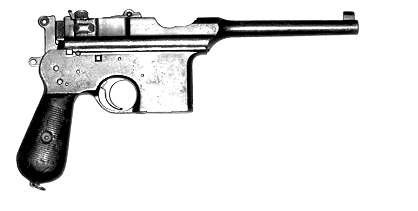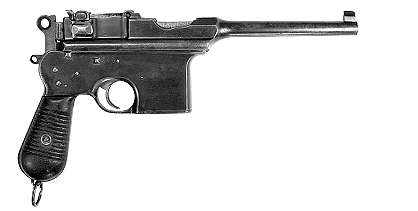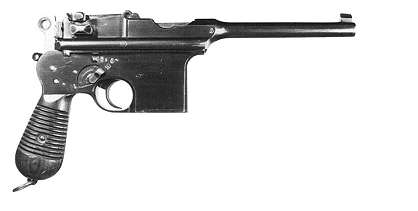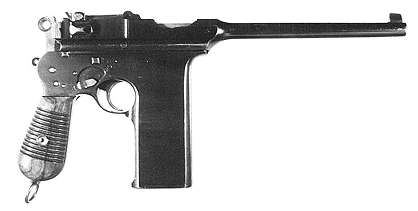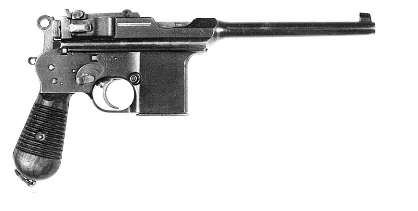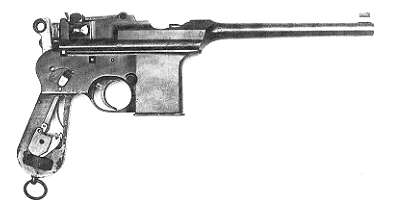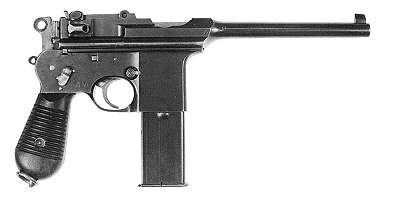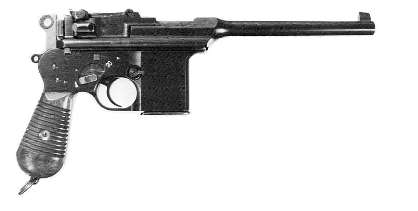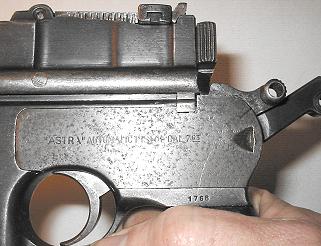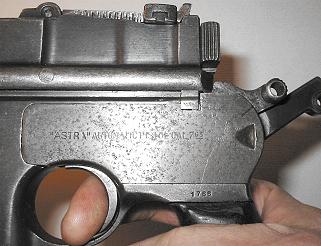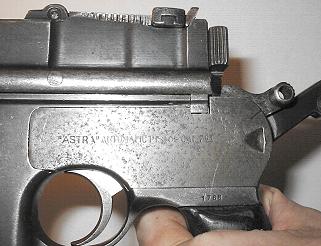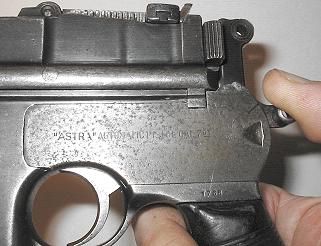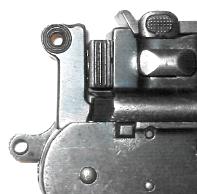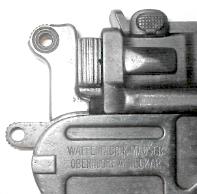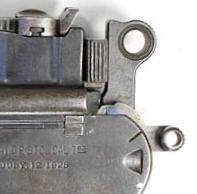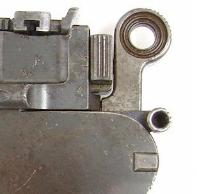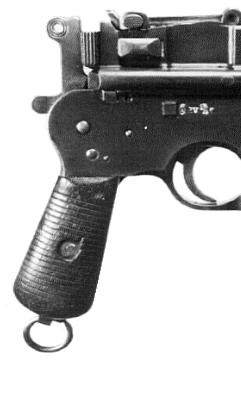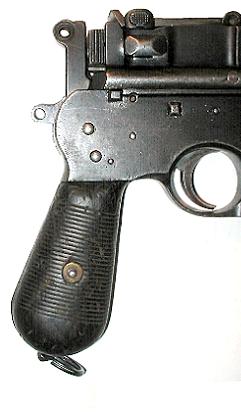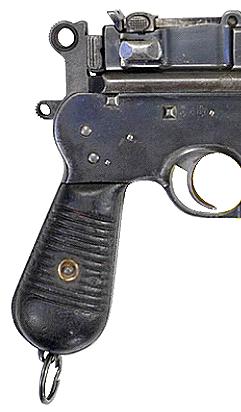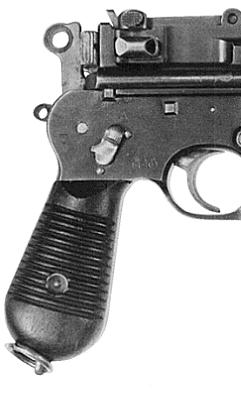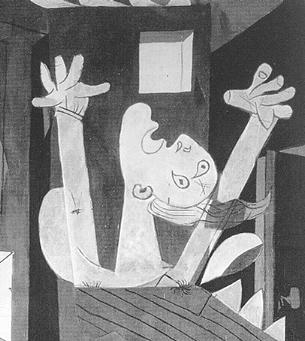Page 2 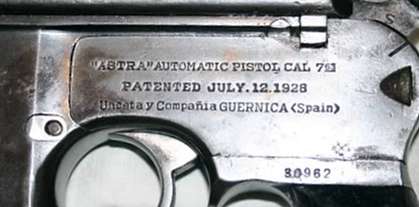
Three-line address on a Model 903 sideplate Page 1 • Astra 900 Series • Model 900 • Model 901 • Model 902 • Model 903 • Model 904 • Model F • Model E • Page 2 • Model Summary • Holster/Stocks • Special Orders • Stylistic Evolution • Markings • Production History • Sources • Model Summary
Holster/Stocks 
Model 901, serial 11407 [photo modified from Pérez] All 900 Series guns were sold with shoulder stock/holsters. These were blatant copies of the Mauser product, right down to the checkering pattern on the lid release button and the wire loop on the lid hinge. There was a bit more removal of wood on the inside, to accommodate the conspicuous 900 Series bulge at the top of the magazine well. The shape of the release catch in the wrist iron was very slightly different from Mauser's, but hardly enough to get excited about. All 900 Series stocks were numbered to their guns. The full serial number was stamped in the usual very small type size on the left side of the release catch (on the underside of the wrist iron), and in a bigger type size into the wood on the inside of the stock lid. The overall length of the stock varied with that particular model's barrel length. This is not too surprising, as the barrel had to fit inside the stock when the gun was holstered; so, longer barrel, longer stock needed. The barrels of most models of the 900 Series (Models 903, 904, F, and E) were 160mm long, and their stocks were 380mm long (14.96 inches). Barrels on Models 900 and 901 were 20mm shorter, and so were their stocks (360mm, or 14.17 inches). The barrel of the Model 902 was 20mm longer, as was her stock (400mm, or 15.75 inches). All of them were too short for proper rifles so far as I'm concerned. The biggest stock, the 400mm one for the Model 902, had a big hole cut out of the bottom edge, so that the gun could be holstered, and the end of the 20 round fixed magazine would hang out in the air. A leather boot could be snapped over it, then unsnapped when using the holster as a stock. It doesn't sound like it was a very satisfactory arrangement. It wasn't even original, but was copied from the stocks for the Beistegui 20-shot guns. This was the only 900 Series holster/stock with this feature. Mauser stocks for their ancient 20 shot guns didn't use a separate boot, but just made the stock out of a huge piece of wood, big enough to take the whole magazine - another unsatisfactory arrangement, I'd guess. The 380mm stocks, as found accompanying the Models 903, 904, F, and E - all guns with detachable magazines - had extra internal cuts in the wood to clear the flange on the bottom of the 10 shot magazine. These guns couldn't be holstered with their 20 shot magazines. Special Orders Unceta would occasionally make special order guns with slightly different features. Guns with slightly longer barrels or chambered for different calibers (primarily 9mm Largo) occasionally turn up. Ezell mentions some guns chambered in 9x19mm, but I'm skeptical. Some guns, notably the Models 902 and E, were made in semi-auto only, rather than select fire. Apparently there were a few guns made in full-auto only. How that would be a useful feature is beyond me, but a customer is a customer, I suppose. Unceta also offered gaudy finishes (gold damascene or silver inlay) as a factory option, with pearlite or strange yellow plastic grip panels. The only special orders with any surviving factory documentation seem to be these guns with special finishes. The batches of guns (Models 900 and 903) sold to Germany in 1940 and 1943 had no special features or markings. Stylistic Evolution The very first of the 900 series, the Model 900, started out with very Postwar Bolo-like features (except for the longer barrel) - a small ring hammer, small Bolo-like grips with 22-line walnut grip panels, a lanyard ring pivoting side-to-side, and a solid safety lever knob. The knob looked like that on the Mauser New Safety, although the Astra safety itself never worked like the New Safety, which Mauser had introduced in 1915. In fact it shared the fault of the earlier Mauser safety - if the trigger was pulled with the safety lever in an intermediate position (not fully engaged or disengaged), the gun wouldn't fire, but, even with no pressure on the trigger, it might fire as soon as the safety was switched fully off. Not a great situation, but there's no indication that anyone at Unceta was particularly concerned.
Safety lever knob. Well before serial number 100, knobs with through-holes, like the knobs on Mauser Prewar Commercials, began to appear. Either type of knob might appear on any particular gun up through about serial number 1000, when the solid knob disappeared for good. The mechanical function of the safety mechanism was unaffected by the change. Grip and lanyard ring. A decent full-size grip appeared at around serial number 1200. The lanyard ring changed at the same time, pivoting fore-and-aft, just like the ring on prewar and wartime large-grip Mausers. The new large grip panels had 27 lines. These narrow lines definitely persisted up through at least the mid 5 thousand range. Grip panels. By the time serial numbers reached the early 7 thousands, the 27 line grip panels had disappeared, replaced by panels with twelve much wider and coarser grooves, resembling those on the Mauser M-30. Unlike Mauser practice to that time, none of the Astra grip frames were step frames - all had front and back straps of constant thickness, simplifying frame and grip manufacture but adding weight. Mauser followed suit, eliminating the old step frame in 1930. Hammer. Around the same time as the switch to the coarser grip panel grooves, the early-type hammer with the small ring was replaced by an odd style with a large ring. The early Astra hammer looked very much like the Mauser small ring hammer as made through the 1920s, though a trifle shorter front-to-back. It was also slightly longer, because the Astra barrel extension was a bit taller than the Mauser version, so the Astra hammer had to stick a bit further out above the frame.
There were no other stylistic changes through the end of Model 900 production in 1941.
Markings There are very few identifying markings on 900 series Astras. The series number (900 Series) doesn't appear on the guns, and the vast majority of guns weren't even marked with model numbers. However, these guns have loads of numbers. Almost all the parts are numbered to their guns, but not particularly conspicuously. Most of the numbers are on interior or hidden surfaces. Numbers on metal parts are in several type sizes, all very small. The numbers stamped into wood - on the inside of both grip panels and the inside of the stock/holster lid - are in a much larger type size. The only prominent number is the frame serial number on the left, just above the grip, also in a rather small type size; the position markings near the select fire switch (on select-fire guns only, of course), and the sight range calibrations. The sight range calibrations were very much like those on the Mauser 50 to 1000 meter sight leaves. Note that unlike Mauser, Unceta never deleted the "900" range on the 1000m sight leaf. Guns chambered in 9mm Largo had 500 meter sights, very much like those on the 1916 Contract wartime Mausers. On earlier specimens - through at least the very late 1920s - the date of manufacture was stamped, in four good Christian-era numerals, on the frame - but it's hidden beneath the left grip panel. And like nearly all Spanish guns of the period, there are the usual proof stamps, later specimens of which provide a proof date (even if only the year). Grip frame markings. On earlier guns, the company name and address were stamped on the left side of the grip frame (normally hidden by the grip panel). That information gradually moved to the sideplate. But it's always worth seeing what's under the left side grip panel. He's an early 900, serial 1768. 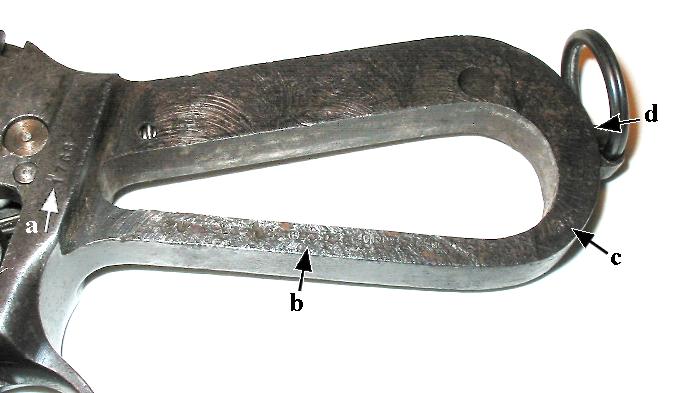
The backstrap is so wide (front-to-back) because the hammer spring strut, plunger, and spring are in there. At b is the factory name and address, At c is a number stamp, 768. This is the last three digits of the serial number. The full serial number is at a, 1768. Why anyone felt it necessary to put the same serial number twice on the same piece of metal is just another one of those little mysteries, but it was a common practice at Unceta, and not just on the 900 Series. At d is another number, 1928 - obviously a date, but a date of what is unclear. Completion date of the gun (after proofing, finishing, etc)? Assembly date of the gun? Forging date of the frame? Nobody knows. Sideplate markings. The significant (and normally visible) markings were confined to the sideplate on the left side of the gun. On most 900 models, these were generic brand and caliber markings, without even a model number. They are known as the one-line, two-line, or three-line "address" sideplates (even though the 1- and 2-line versions included no actual address at all). The first, the 1-line "address", was a generic Astra marking with caliber. Later a patent date was added, making the 2-line "address", and still later a company name and real address were added, making 3 lines. There was a perfectly good four-line address as well, but most observers don't seem to realize it. Only two models in the 900 series, the 904 and F, had non-generic sideplates, with their model designations included - and the model number on the 904 sideplate was clearly an afterthought. So, while Unceta would change the sideplate markings from time to time, most are of little significance so far as identifying a gun. Some models might be found with one-, two-, or three-line sideplate "addresses", depending solely on when a particular gun was made. They are clues to dating a gun. Starting in 1933, Unceta production records are adequate to date (more or less) a gun by serial number, but for earlier production there's considerable guesswork involved, and we need all the help we can get. Here are all the sideplate markings Unceta put on the 900 Series guns, in chronological order. Prototype. The very earliest guns didn't have the standard production sideplate markings, but a more generic caliber marking. Antaris, page 145, shows serial number 4 with this sideplate marking - It seems safe to assume that only prototypes had this marking, which translates as a simple Mauser Cartridges caliber 7.63. Unceta would definitely want the Astra name and not the Mauser name on the sides of production guns. 1-line "address". Production sideplates certainly up to the 4000 serial range had the one-line "address". The conventional wisdom is that the one-line "address" appeared on sideplates up to the 12000 serial range, and, while I can't verify that (since I've encountered an inexplicable shortage of specimens in the 4000 to 12000 serial range), I can't say that the conventional wisdom is wrong. 2-line "address". The two-line "address" had certainly appeared by the mid 12 thousand serial range. This time I believe that the conventional wisdom, which claims that the succeeding three-line address appeared at serial 20000, may be a bit off. I think the two-line "address" may have persisted as high as the low 22 thousands. I've seen a 2-line address sideplate on a gun in the 21 thousand range, but didn't have the opportunity to verify (from the numbers) that the plate was actually original to that gun, so the jury's still out. PATENTED JULY.12.1928 3-line address. Finally, with the "three-line address", an actual address appeared - not surprisingly, it was Guernica, Unceta's home town since before World War One. And here's what it almost always looks like - PATENTED JULY.12.1928 Unceta y Compañia GUERNICA <Spain> And now, a little-known fact - I have seen, without question, the exact same address, but with (Espana) - definitely not España - instead of <Spain>. It was on what looked like a perfectly ordinary 900, serial in the 27000 range. As usual, the serial number could be bogus, as I wasn't able to verify that the sideplate wasn't a mismatch. But say Espana, it did.Models 900, 901, 902, and 903 would have whichever of the above three sideplate markings was in production when the gun was made. The Model 900 and Model 902 can be found with all three sideplate "addresses". The Model 901 might be found with one- or two-line "addresses". I believe the 903 always had the three-line address. Model 904. All nine specimens of the Model 904 had this sideplate marking - Unceta y Compañia GUERNICA <Spain> M O D 9 0 4 Model F. All Model Fs had a special sideplate marking - Unceta y Compañia GUERNICA (España) Pista Ametra is short for Pistola Ametralladora, or Pistol Machine Gun. 4-line address. And finally, the Model E always seemed to have this sideplate marking - PATENTED JULY.12.1928 Unceta y Compañia S.A. Guerñica MADE IN SPAIN I call it the four-line address because it's generic (no model designation) and, well, it has four lines. But this name is not yet widely recognized. (For that matter, neither is the Model E.) So, to sum up who might be found wearing which sideplate -
Other Markings Proof stamps See the tedious details on the Spanish Proofs page. "Hope" For no known reason, the earliest Model 900s - Antaris says to about serial number 500 - had the mystery word Hope on the barrel or top chamber flat. See photos of a few of these marks here. The Hope mark also appeared on other Astra models, but finally disappeared about 1927. The frames of the earliest Model 900s are, in fact, helpfully stamped with the date 1927 under the left grip panel, implying that they were made in that year. But perhaps the date stamp was put on later. No original documentation about this matter is known. Much has been made of the claim that the Spanish word for Hope is Esperanza (which is true enough), and that Juan Esperanza was one of the founders of the firm, when it was Esperanza y Unceta. The partners split up in 1926, leaving Pedro Unceta with the firm, soon renamed Unceta y Cia. Why would one of the founder's names, in English translation, be one of the most prominent markings on some guns? And if that's his name on there, why would it still be on there after his departure from the company? Or were the guns actually made before 1927? The mystery remains. 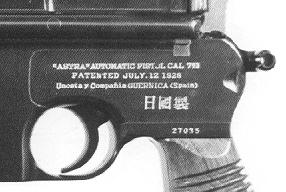 Crypto-Chinese
Crypto-Chinese
Antaris reports a batch of Model 900s in the 27000 - 27899 serial range with Chinese characters added to the sideplates, below their three-line addresses. These characters translate as "Made in Japan", which was of course a lie, Guernica being nowhere near Japan. That's pretty wacky, but Antaris further reports that these guns were actually sent to the Euzkadian government in 1937, which is even wackier, as that was an autonomous government in the Basque area set up during the Civil War, and what use they could have for Chinese characters there is a real puzzle - Basque is bad enough without throwing in Chinese too. My suspicion is that what actually happened was that Unceta hadn't yet tried to ship these guns to the agent in Japan, and the government seized them sometime before May, 1937. (After May, the factory was in the hands of the Nationalists - see below.) These Chinese characters have been reported in one of "the books" (Ezell, Handguns of the World) as meaning Made in Spain, which is not correct. I can read just enough Chinese to successfully avoid seafood restaurants, and to know that the little Chinese phrase visible in the photo says Made in Japan, not Made in Spain. And expensive oddballs The standard Astra finish was traditional rust blue. The 900 Series had some small parts left in the white, and some heat blued. Unceta didn't drop the rust blue and switch to a more modern (that is to say, cheaper) process until the 1950s. But one of the options offered by the factory was exceptionally gaudy finish in gold damascene, or an only slightly more sedate silver engraving. Factory records on these show that fewer than a dozen 900 Series guns were abused in this fashion. The sideplates on these might have anything at all on them - no text, a special text, the same text as standard sideplates but in different locations, or the standard sideplate but with the letters picked out in gold. Production History Here are production totals for the 900 Series, derived from numbers given in Antaris, page 141. Unceta data for earlier years was not available, so the record starts in 1933, with serial number 25001. Antaris arranged Unceta production records by serial number, which isn't exactly what we want. (Here it is the way Antaris arranged it.) In the table below I have rearranged things to show what quantities were made in which years. Antaris gives some data for two year or longer blocks. I suspect this was when production of a particular block of a specific model with contiguous serial numbers spanned those years.
1936 was the beginning of the end. Unceta filled the Guardia Civil order for the Model F with just about all of 1935's 900 Series production, then in 1936 started assembling a batch of Model 903s. But history was about to intrude. At that time, Unceta's major product wasn't the 900 Series. The big seller was the Spanish service pistol, the Model 1921 or Model 400 (Model 1921 was the government designation, 400 was the factory name; the guns were marked with both, MODELO 1921 (400), on the top of the slide). This was chambered for the standard Spanish military pistol round, 9mm Largo. A smaller version, the Model 300, chambered in .32ACP or 380ACP, was effectively (albeit unofficially) a military arm also, as it was very popular with many government agencies - the Cuerpo de Prisiones (Prison Guards), Seguridad de Puertos (Port Security), Vigilancia de la Pesca (Coast Guard), Carabineros, various police departments, military schools, etc. 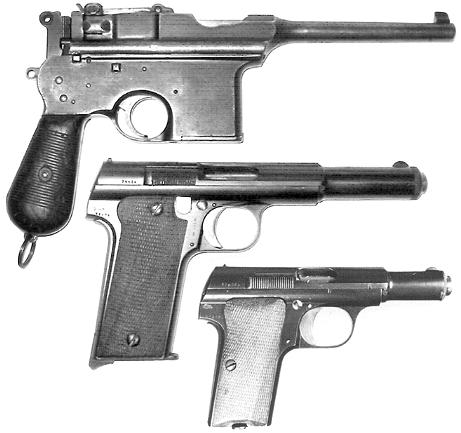
Models 900, 400, and 300 In the mid-1930s, Unceta was making very roughly 3000 Model 300s and 4000 Model 400s annually. In contrast, only about a thousand 900 Series guns were made in 1935. In July 1936, inspired by creeping Bolshevism in the Republican ranks (breakup of major estates and land distribution, workers marching around with fists in the air, the usual communist schtick), arson of churches and outrages against Catholic priests and nuns, and a couple of political assassinations, army officers led a rebellion of Foreign Legion troops in Morocco. With that, the Spanish Civil War was off to a fine start. At the outbreak of war, demand for small arms increased, as it usually does. Production of the Models 300 and 400 jumped to a combined rate of around 25,000 a year. Although the rebels made rapid progress on several fronts, the Basque region, including the pistol factories in Eibar and Guernica, remained under the control of the Republic. Unceta's output through the end of 1936 was shipped to Republican arms depots. As for 900 Series guns, a few in stock - probably no more than a hundred or so, mostly Model Fs, but including a few Model 903s and 904s - went to the Republicans, most eventually ending up with the Guardia Civil. In October 1936, the Republican government granted limited autonomy to the Basque region, or Euzkadia. Despite the ultra-Catholicism of the Basques, the Euzkadian government declared its allegiance to the Republican government in Madrid, and then asserted control of the arms factories within its territory. Unceta's output, primarily Model 300s and 400s, thereafter went to the Euzkadian government. This included about two thousand leftover Model 900s.
Franco's Nationalist troops occupied Guernica two days later. The Unceta factory, by chance undamaged by the bombing or fires, then started manufacturing guns for the Nationalists, and continued to do so until the end of the war in April 1939. Both sides, Nationalists and Republicans, used the standard service sidearm, the Model 400 in 9mm Largo. Neither was particularly interested in the 900 Series (although they were happy to grab guns already made), so Unceta - whilst under Republican, Euzkadian, or Nationalist control - made very few. No 900 Series guns at all were made in 1938. Some 903s made before the outbreak of the war (but probably uncompleted) remained in factory storage, and more were made after the war's end, leaving a stockpile of about 2000 Model 903s by early 1940. Of course by the time the Civil War ended in Spain, the Second Sino-Japanese War was well on its way, and shipments to China were cut off. Fortunately (I suppose), Europe was starting to become a decent market again. Although Spain never officially joined the Fascist Axis, the government allowed Unceta to sell about a thousand Model 903s to Germany in 1940, shipping them by way of Hendaye, in the Basque region of Occupied France. Unceta made another thousand Model 900s in 1940-41, and sold them and the remaining stock of a thousand Model 903s to Germany in 1943. (Antaris points out that, although Unceta invoiced the Germans for 1,000 Model 903s, the serial number records imply that thirteen of them were actually 902s.) The last shipment of arms from Unceta to Germany was in July 1944, but those were Model 300s and 600s - no Model 900s. A week later the advance of the Anglo-American forces through France cut off further contact between Spain and the Wehrmacht. Those Model 900s and 903s shipped to Germany in 1943 were the last 900 Series guns made for a few years. The guns sold to Germany had no unique identifying markings. Depending on exactly when they were proofed, the proof triad may have migrated away from the late position just above the grip, back up to the old position just under the barrel extension rail. I'll have to see more samples from the 1943 shipment before I can sort that out. But there was none of the usual decoration as found on service guns made in Germany or the occupied territories (Waffenampt, factory letter code, etc.) because of course Spain wasn't under Nationalsozialistische occupation, and the guns were delivered from stock rather than being made to meet a special order or contract. So the only way these guns can be identified is by serial number. Here are the serial numbers of all 900 Series guns shipped by Unceta to Germany during the war (basic data from Antaris, pages 142 and 241, cross-checked and arranged by me) -
There remained a coda to the 900 Series saga. From 1949 to sometime in the 1950s, Unceta made 548 of a new model, the Model E. Perhaps someone found a closet full of partially-machined Model F parts, though why Unceta would have made such parts in the first place is mysterious, as the Guardia Civil order was for a definite quantity of guns, and a 50 to 60 percent overrun would have been extravagant. I suspect that after completing the Model F order in 1935, Unceta had planned to modify other 900 Series guns to incorporate the frame, magazine, and barrel extensions of the Model F, and would probably have done so if production hadn't been interrupted since 1936 by one war or another. These later models wouldn't have had the rate retarder mechanism and would have been in 7.63mm, with 1000 meter sights. So the stash of what looked superficially like Model F parts may have been intended for other guns, just with Model F-type changes. This is pure speculation. In any case, Unceta finished these 548 guns in such a way as to emulate the Model 903, and they seem to have been sold as 903s. Most of the Model Es were sold to Egypt, Iraq, Pakistan, and India. They weren't red-hot sellers - the last didn't go until 1961. Sources Sources for this page were, as usual, my own database (which, truth be told, is sparse for Astras, as they're much rarer than Mausers), and the usual suspects as cited on my Bibliography page. The major reference for Astras of all stripes is Leonardo Antaris, Astra Automatic Pistols. This was published in 1988 and is now out of print. Leonardo A. had access to the factory records, so much of his information has a more solid basis than similar information about guns made by Mauser or Beistegui or the various Chinese arsenals. Unceta has since fallen on hard times and may be permanently defunct by now, so the current whereabouts of those records is uncertain. Most 'net information I stumble across about Astras appears to be cribbed from Antaris, although never attributed. I've found a few errors and typos in the book, but in general I consider it a reliable reference. I believe all the Astra material in Spanish Handguns was derived from Astra Automatic Pistols. Artemio Pérez, Las Pistolas Españolas tipo <<Mauser>>, is devoted in part to the Astra 900 Series. Some material is probably derived from Antaris, but not all. Some Unceta sales material is reprinted in Ezell, Handguns of the World. The photos are either my own, or processed from photos of guns on dealer or auction sites. The select-fire guns (which is most of them) are expecially rare around these parts, as they're machine guns. I'm unlikely to see any originals in this country, so I was reduced to stealing photos from the books. Some of the photos were scanned from Antaris, then processed by me - scaled, cropped, optical aberrations corrected, and cleaned-up in general. The arrows or circles emphasizing features of interest were added by me. A couple of photos from Erickson & Pate were similarly treated, and one from Cormack. For those of you who live on Mars or at some similar distance and so don't know these things, I'll mention that the painting fragment is from Guernica, by Picasso. |
|||||||||||||||||||||||||||||||||||||||||||||||||||||||||||||||||||||||||||||||||||||||||||||||||||||||||||||||||||||||||||||||||||||||||||||||||||||||||||||||||||||||||||||||||||||||||||||||||||||||||||||||||||||||||||||||||||||||||||||||


